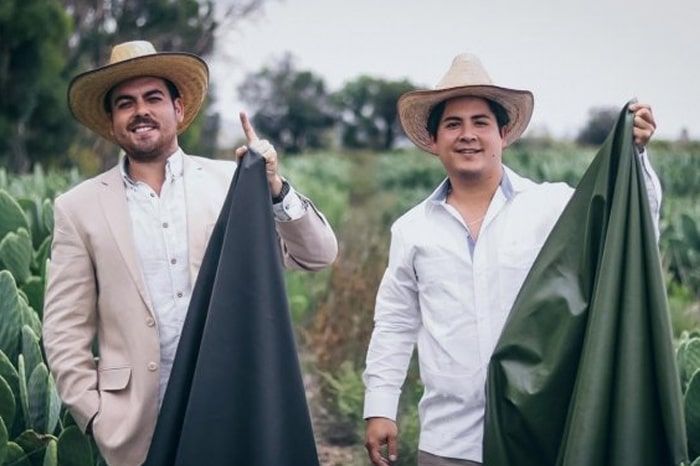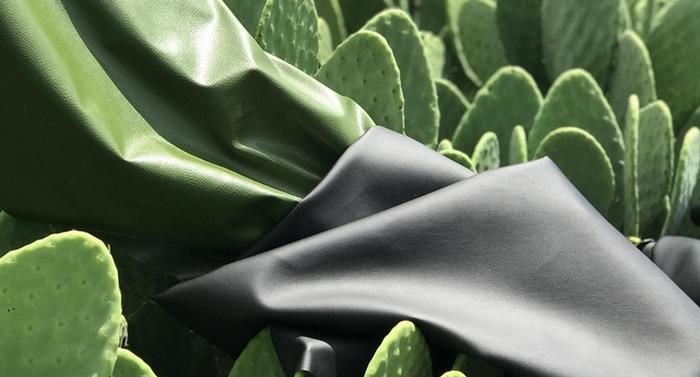Mexicans create cactus leather material that triumphs in the world
Today, eight years later, they are partners in their own company and developed a synthetic leather made with nopal, also called Cactus Leather.

They are partners in their own company and developed a synthetic leather made with nopal, also called Cactus Leather, for the translation they gave it in English. With this idea, they intend to revolutionize the Mexican textile industry. One night outside a bar in China, Adrián López and Marte Cázares met. For them, it was a pleasant surprise to meet another Mexican in those lands. Adrián, who studied Politics and Economics, worked in a furniture company and Marte, a graduate in International Business, was dedicated to the field of fashion.
Both were born on the same day, in the same year, both lived in Taiwan, studied careers related to the economy, and have a particular interest in innovation and care for the environment. López y Cázares' proposal aims to reduce animal deaths from the sale of leather and fur, as well as water savings in the textile industry.
"We agree that all industries that handle synthetic leathers, such as automotive, furniture, and fashion, face a very serious problem that is the environmental footprint left by their products," says Adrian. All these similarities, added to their ideas and knowledge, make them a winning team. Little by little, they attract the gaze of designers interested in working with them.
However, they point out that furs derived from plant material are not something new in fashion. But theirs is the first in the world made with nopal and Mexican. Adrián and Marte have participated in fairs and exhibitions in Italy, Australia, and Slovenia. Among the presentations they have made, the one they consider most important is the Lineapelle 2019 Fair, held in Milan, Italy, from 2 to 4 October. There, they had a stand where they exhibited samples and products such as bags, backpacks, and wallets.
"This material was very well accepted, not only in the fashion industry but also in automotive and aeronautics. Even one speaker said that our material was suitable for use in luxury brands," says Adrian. World Bank studies estimate that 20% of all water pollution is caused by the processes of treatment and dyeing of textiles. This is predicted to increase as demand for clothing grows at the same rate as the world's population.

National symbol
Adrián and Marte consider that nopal is perhaps the country's most emblematic plant, because, in addition to its proven properties, it allows other entrepreneurs to develop more sustainable projects. "We feel very proud because we use one of the symbols of our flag, such as nopal. By launching this skin we are making known something characteristic of the country", says Marte Cázarez.
Nopal has been present in the national gastronomy since before pre-Hispanic times. Various anthropological studies place the consumption of this plant between 7,500 and 5,000 years before our era. Millennia later, with the settlement of Mesoamerican cultures, especially in the Valley of Mexico, gained greater cultural relevance to be a key element in the myth of the founding of the Mexica city of Tenochtitlan, which is reflected in the National Coat of Arms.
For these young people, it has a special meaning, because, in their passage through different countries, says Mars Cazares, "everyone recognizes it as part of our identity, they see a nopal and say "Oh, Mexico". Of the 377 species of cactus Opuntia, the genus to which nopal belongs, 164 grow in our country, according to data from the Commission of Natural Resources and Rural Development of the CDMX (CONAR).
Mexico is at the top of world exporters of cactus suitable for consumption, with a production of more than 812 thousand tons in 2018, according to estimates made by the Secretariat of Agriculture and Rural Development. In addition to innovation, the creators of Desserto, the commercial name of his invention, say that its production generates jobs in Guadalajara, the city where maquila is made.
"Indirectly, about 50 people here in Mexico benefit and we hope to create more, so that this material is produced on a larger scale and we can support the growth [of the local economy]," Adrián says. Harvesting nopal is a high-risk activity for producers due to fluctuating consumer prices. Columba Jazmín López, director of CONAR at CDMX, says that although crops remain constant, there was a recession in the Mexican capital, and almost half of the hectares planted were lost.
"Currently it is in Milpa Alta, where people dedicate themselves to this, there are 2,630 hectares of sowing, eight years ago, we had a record of 4,331. The land was lost due to environmental issues and irregular settlements in the cultivation zones". The official believes that projects like Desserto help to recognize the work in the field and increase the consumption of this plant.
On the verge of bankruptcy
The creation of nopal skin did not happen overnight. It is a project that took two years to materialize. Adrian says they sacrificed the stability they had in China to go back to Mexico and start the research: "The most complicated part was abandoning our jobs to focus on this dream. Obviously, our friends and people close to us suggested that we not do it because it was too risky".
Since they are not scientists, they relied on a group of experts to test the material. The aim was for the result to be resistant, flexible, and breathable leather. "It was very difficult to do the research work and achieve the bonds between the molecules of organic and synthetic chemicals. We even had to get deep into nanotechnology to achieve our goal," adds López Velarde.
Marte Cázarez explains that Desserto's funding almost left them bankrupt: "We were very optimistic about our project. We looked for ways to maximize the use of our resources and avoid unnecessary expenses. We had to borrow from friends to keep working". When the final material was obtained, the question arose as to how to make the nopal skin known: "Our initial question was, where are we going to launch it? In Mexico, we are not very involved in ecological issues like the markets of other continents".
They then created the company Adriano Di Marte to break into the industry and contacted designers to get to know and work with Desserto. They mention that their stay in Australia was more successful than they expected, as some tourism companies in that country already made their orders to use nopal skin in baskets of hot air balloons, a market they had not contemplated. "This material went around the world, after the acceptance it had in Lineapelle we already collaborated with groups of global stature so that they can integrate it into their next collections," conclude Adrian and Mars.




